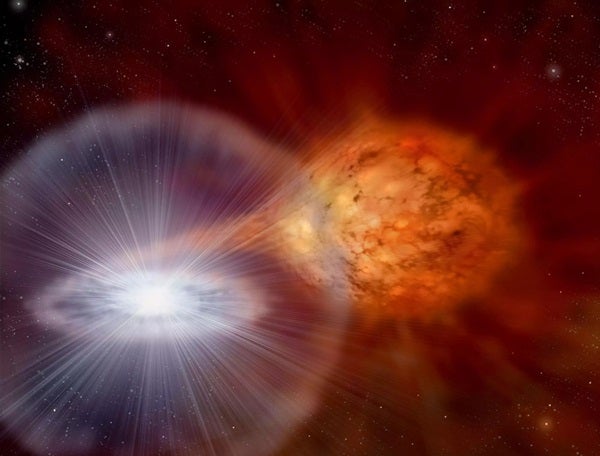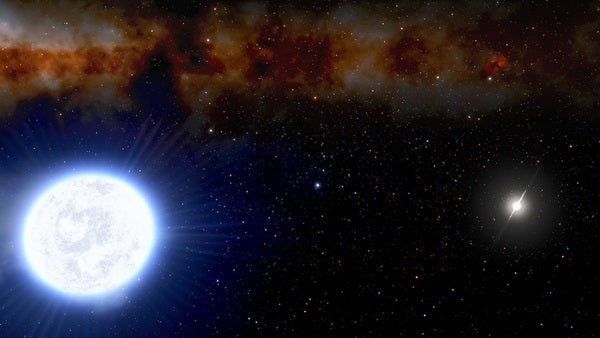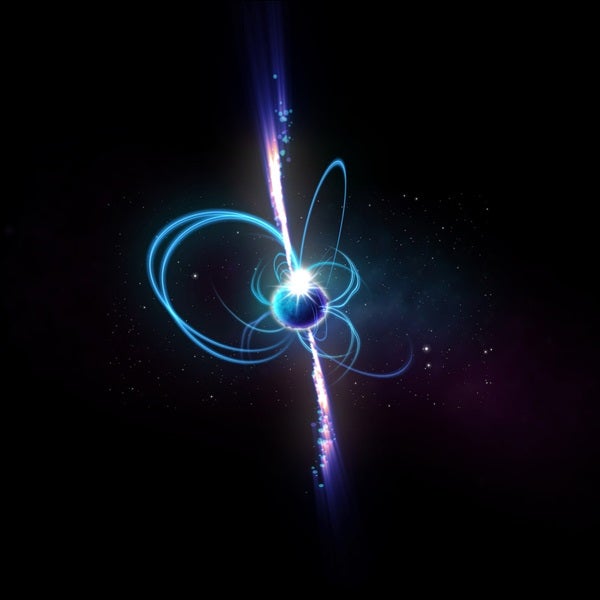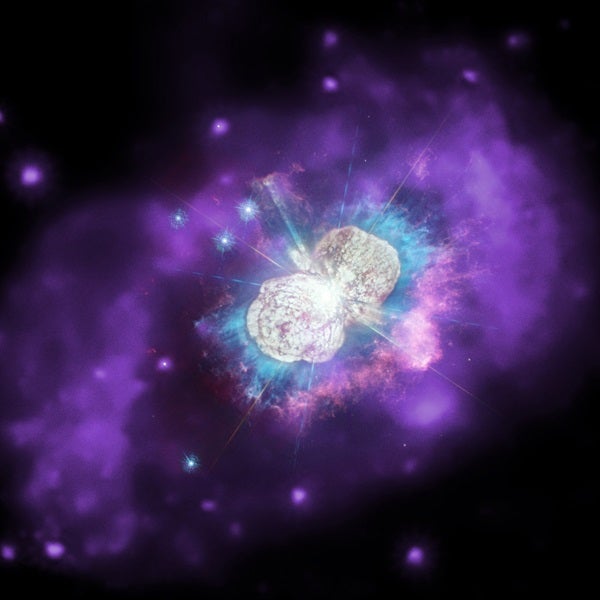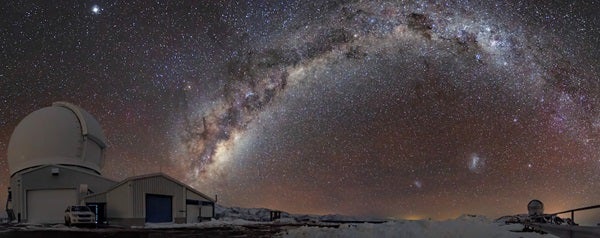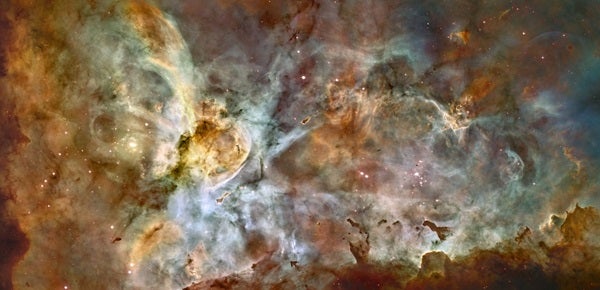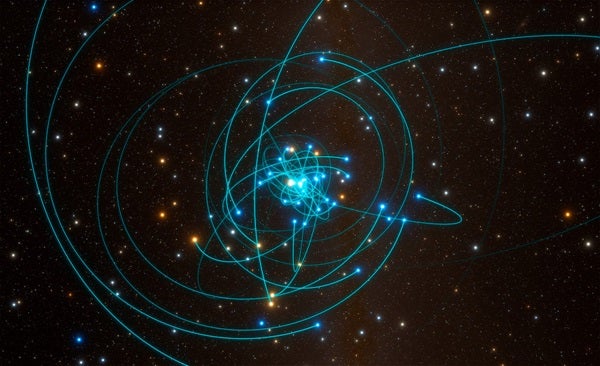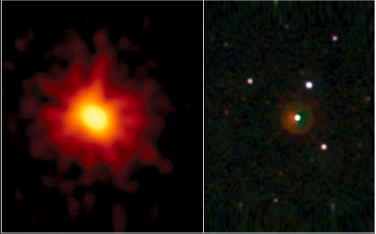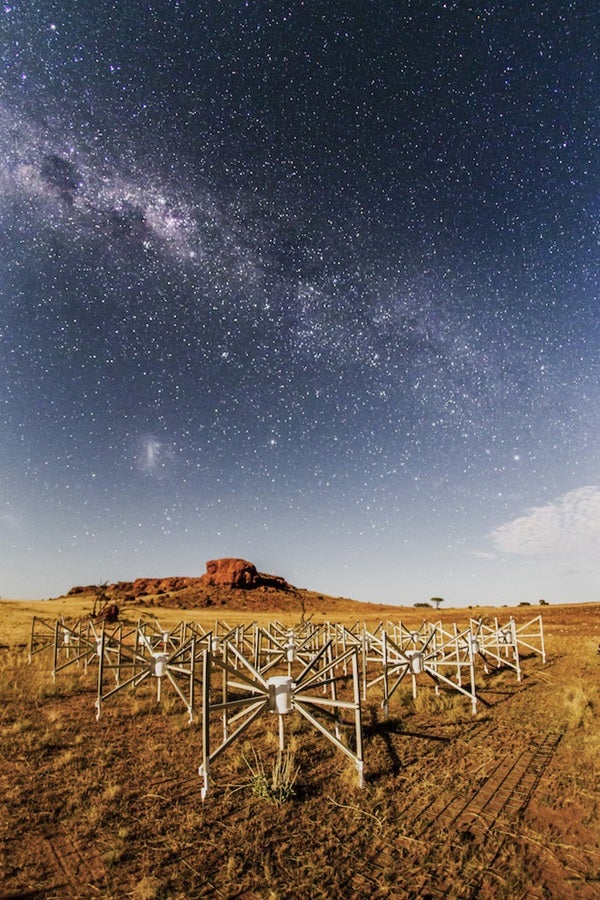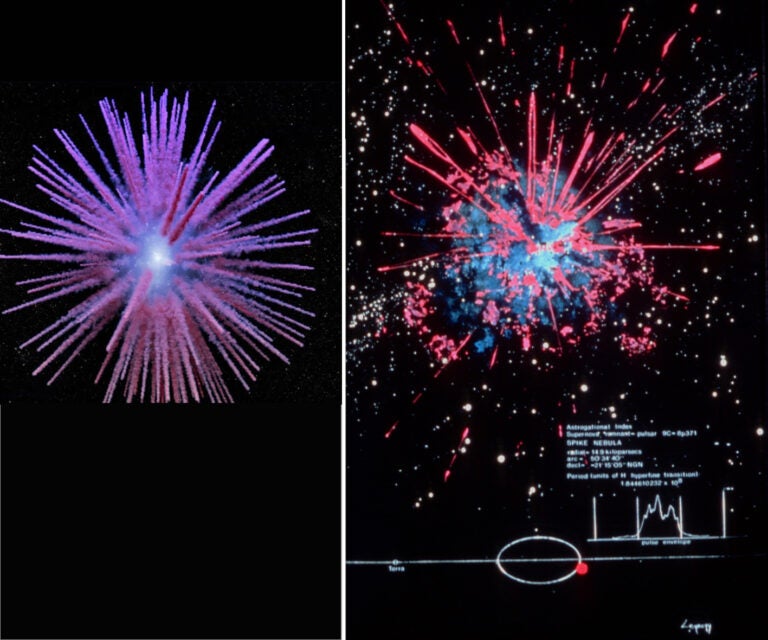Recurrent novae are caused by a white dwarf (left) siphoning matter away from its aging companion star (right), as seen in this artist’s concept. Periodically, this material builds up and ignites in a thermonuclear explosion. While this usually takes years or decades, in the extraordinary case of V2487 Oph, it happens every day.
Among the Milky Way’s 100 billion stellar denizens, there is no shortage of showoffs.
Some of these heavenly bodies have long been in the limelight, like planetary nebulae, featuring beguiling billows of expanding gases. Others, such as luminous blue variables, are new to the scene and already flaming out, wildly unstable and burning with the intensity of millions of Suns as they expand and contract. Many of these stars will end their lives in explosive supernovae — living fast and dying young, briefly igniting our skies with the brilliance of entire galaxies before disappearing forever.
For decades, astronomers thought they understood the galaxy’s stars fairly well, and could trace their dramatic story arcs with charts and models. Based on observations and calculations, it seemed that stars cycled through life phases as predict- ably as a three-act screenplay.
But in recent years, new methods and instruments have revealed stars that exhibit shockingly unconventional behavior. These are true standouts, modern celebrity superstars that tantalize us with their secret lives and exotic physics. Young stars whirling around our galaxy’s supermassive black hole at fantastic speeds; pulsars spinning like madcap lighthouses with the precision of atomic clocks; stars that don’t bow out with a single bang, but keep coming back to relive their former glory.
These extraordinary orbs have stories worth telling, and astronomers are scrambling to bring them to light.
The white dwarf 4FGL J1120.0–2204 (left, foreground) orbits a millisecond pulsar (right, background) in this artist’s concept. The system is still in its early days: The white dwarf has yet to shed its outer layers and the pulsar is still spinning relatively lazily.
A hidden co-star
Some stellar celebrities dodge publicity and live in the shadows, leaving anonymous clues as to their whereabouts for scientists to decipher. Sam Swihart of the U.S. Naval Research Laboratory in Washington, D.C., is an expert at spotting them. Recently, he pored over 12 years of data from the Fermi Gamma-ray Space Telescope, focusing on one such reclu- sive object: the source of one of the brightest unidentified gamma-ray signals on record, called 4FGL J1120.0–2204 (J1120 for short).
Gamma rays pack the most powerful punch in the electromagnetic spectrum and cannot be focused or reflected by mirrors. As a result, gamma-ray detectors cannot produce crisp images, and objects emitting gamma rays appear to occupy patches of sky sometimes as large as the Full Moon. Zeroing in on their sources requires observations at other wavelengths. Using X-ray and optical data, Swihart’s team was able to pinpoint a hot blue star at J1120’s coordinates last year. But a single blue star could not produce the level of gamma rays that were barreling across 2,600 light-years to Earth. Therefore, this star had to have a secret companion.
To solve the mystery, Swihart employed the Southern Astrophysical Research Telescope (SOAR),
a 4.1-meter telescope with a sophisticated spectrograph, sitting atop Cerro Pachón in Chile. Through analysis of its optical and near-infrared light, Swihart’s team discovered that J1120’s detectable star is much hotter and denser than the Sun. After deter- mining its temperature and surface gravity, thereby deducing its mass, they mea- sured the Doppler shifts in the star’s light as it swung toward and away from Earth. This showed the star has a 15-hour orbit and, after it burns up the 2 billion years’ worth of hydrogen left in its tank, will eventually become a white dwarf just one-fifth its current mass.
But what is it orbiting? Given the star’s ultra-fast orbit, the only object with the mass to occupy center stage of the J1120 system yet remain invisible to us is a neutron star. (A black hole would far exceed the measured mass.) This neutron star is likely a millisecond pulsar (MSP) whirling in place so fast that it beams hundreds of radio pulses toward Earth per sec- ond, and turbocharging its spin by sucking material from its companion.
When your dance partner is a neutron star packing the weight of an entire mountain into a single teaspoon, intimacy can be dangerous business. “These are some of the most extreme objects in the universe,” Swihart says. “You’re talking about some- thing that’s twice the mass of the Sun and the size of Washington, D.C., and it’s spinning hundreds of times every second with extremely high magnetic fields that would just wreck you.”
J1120 is the first suspected MSP system to be discovered before it has evolved to its final stage: Its white dwarf
is still puffed up, its layers bloated. Catching the white dwarf at this early stage makes J1120 a relative teenager, Swihart says — and also a missing link in our under- standing of how MSPs form.
Stealing the show
Then there are the stunt doubles. Called supernova impostors, these stars mimic their peers with an explosive curtain call, only to make a comeback decades later. However, they’re hard to study: Most of the dozen or so known supernova impostors are found in distant galaxies millions of light-years away.
“The one exception is Eta (η) Carinae, which, freakishly, is only 7,500 light-years away,” said Kris Davidson of
the University of Minnesota at a June 2021 press conference hosted by the American Astronomical Society. “This is the only supernova impostor, or giant-eruption survivor, where we can see details.”
Eta Carinae and the surrounding Homunculus Nebula show off a range of false colors in this composite image of optical light (white), ultraviolet (cyan), and X-rays (purple).
In 1837, Eta Car suddenly leapt from relative obscurity to become the second brightest star in the sky. Davidson estimates that it lost 10 to 20 percent of its mass before its brightness peaked in 1843. Originally more than 100 times the mass of our own star — typical of all such impostors — it expelled the equivalent of 15 to 20 Suns before fading in the late 1850s.
The event had seemed like a normal supernova, with a blinding grand finale of self-immolation. But in 1892 it faintly reappeared as a 6th- magnitude star, only to fade again a few years later. Some astronomers predicted it would return to its peak brightness by 1900. In fact, it is taking much longer: Nearly 200 years after its initial outburst, Eta Car has recovered only to about magnitude 4, with erratic periods of minor brightening.
Still, astronomers have closely monitored it for signs of impending eruptions. One potential telltale is Eta Car’s spectral signature, which shifts every 5.5 years when its much smaller companion star swings by. As the stars’ stellar winds collide during these flybys, the system emits less radiation at ultraviolet wavelengths. However, during the last several close passes, this has not happened. Davidson thinks that Eta Car’s outflow has become “almost a normal stellar wind,” and that may presage a major eruption.
“In the next 20 or 30 years, it’s going to change its appearance,” predicts Davidson. The star is already brighter than the Homunculus Nebula surrounding it, and he thinks it could brighten by another magnitude. “When it does, it will ionize the Homunculus Nebula, making it look like a planetary nebula, but 100 times brighter and with a central star,” or, as he also puts it, “A planetary nebula on steroids.”
Giant superflares from a dwarf
Stars like Eta Car are not the only celebrity lookalikes in our galaxy. Supernova imposters are a category of recurrent novae, systems that repeatedly surge on and off. Most consist of a white dwarf gulping gas from its companion until it overindulges, triggering periodic surface explosions up to a million times the white dwarf’s normal luminosity.
There are only 10 known recurrent novae in our galaxy. One, V2487 Ophiuchi, some 21,000 light-years distant, made headlines in January when a team led by Bradley Schaefer of Louisiana State University announced the system was producing stellar flares about 1 billion times more powerful than the Sun’s.
Using data from the Kepler space telescope, his team found that these extreme superflares occur once a day, lasting an hour each episode. The work was published March 2 in Monthly Notices of the Royal Astronomical Society. By comparison, the Sun’s most devastating solar flares in modern times — which set fires in telegraph offices across the U.S. in 1859 and fried power grids in Canada in 1989 — were tens of millions of times weaker.
“V2487 Oph is extraordinary,” says Schaefer. An order of magnitude stronger than all other known superflares, “it’s also fast, pounding every single day. How do you get that much energy?”
Schaefer says the answer lies in V2487’s twisted magnetic fields, which are yanked round and round between the white dwarf and its rapidly orbiting companion. These fields are anchored in the roiling plasma and photons jetting between the two stellar surfaces. When the overstretched magnetic fields snap, they release potentially devastating bursts of electromagnetic energy.
According to Schaefer, this relentless radiation rules out chances of any exoplanet life in the V2487 Oph system. But he adds that its actual nova eruptions, which occur about every 18 years, are even more severe — on the order of a billion times more powerful than the daily flares. A nova eruption is now overdue by six years, and Schaefer says he expects to see it very soon.
Even in the bustling starscape of the Carina Nebula, a celebrity like Eta Carinae (far left) stands out — surrounded by its entourage, the bright, double-lobed Homunculus Nebula.
In late 2020, using spectral analysis from two telescopes in Hawaii, a team of scientists led by Wynn Jacobson-Galán of the University of California, Berkeley, made an unprecedented observation of such a dying star in a galaxy 120 million light-years away. They tracked the target for four months as it grew increasingly unstable and finally exploded, with enormous jets of gas punching outward.
“This is a breakthrough in our understanding of what massive stars do moments before they die,” said Jacobson-Galán, the study’s lead author, in a press release Jan. 6, the same day they reported their find in The Astrophysical Journal. “For the first time, we watched a red supergiant star explode!” The outbursts they saw leading up to the final explosion suggest these stars experience a greater deal of inner turmoil than previously thought, their internal structures shifting before they collapse.
S stars: At the heart of it all
Near the center of the galaxy live stars in a class all their own, called S stars. Many times the mass of the Sun, they orbit the galactic center in as little as a dozen years, reaching speeds that can exceed 1.5 percent the speed of light. The dense gas and dust of the Milky Way’s central bulge long hid S stars from prying eyes, but their existence and secrets began to emerge in the 1990s with improvements in infrared telescopes, adaptive optics (AO), and techniques such as speckle imaging.
Speckle imaging takes rapid short- exposure images to capture the effects of atmospheric turbulence, allowing astronomers to remove those effects from their images. AO uses minutely adjustable tele- scope mirrors to continuously correct for atmospheric distortion by monitoring laser beams bounced off Earth’s high-altitude sodium layer of vaporized meteors.
“I often call [speckle imaging] ‘poor man’s adaptive optics’ because it takes quick snapshots and, in post processing, you figure out what’s going on,” says Andrea Ghez, an astrophysicist at the University of California, Los Angeles, who used this technique to study the center of our galaxy. “All we could tell is that there was an object and you could trace it.” But when adaptive optics came online in the early 2000s, “we saw that the objects we’d been tracking for almost a decade were young, hot stars.”
These S stars are among the most enigmatic stellar inhabitants of the Milky Way: young stars living where old stars should be, thriving in a mysterious, overcrowded region of gravity-warped time and space. But their orbits provide overwhelming evidence of the supermassive black hole at the galactic center. They have also provided powerful confirmation of the theory of general relativity, looping around a deep gravitational well that is perfect for testing Einstein’s concepts under the most severe conditions — the crux of research that garnered Ghez a share of the 2020 Nobel Prize in physics.
To boldly go
Not every astronomer dreamed of being a member of the celestial paparazzi.
As Natasha Hurley-Walker tells it, she always wanted to pilot a starship. When she grew up and realized how impossibly vast space is, she settled for being an astronomer, learning to navigate the cosmos using radio telescopes. She launched her journey aboard the Murchison Widefield Array (MWA), a sprawling, knee-high network of dipole antennas stretched across the parched red sands of Western Australia, 400 miles (640 kilometers) north of Perth. It’s one of the few radio arrays in the Southern Hemisphere doing widefield surveys, scanning huge swathes of sky at a time.
Since 2018, Hurley-Walker has helmed MWA’s GLEAM-X all-sky survey across the Southern Hemisphere, logging some 300,000 galaxies. One of the most startling discoveries came early in the project, when she assigned Tyrone O’Doherty, an undergrad at Curtin University in Perth, to pore over MWA’s copious data. She had him look for something slowly changing over a matter of months. She wasn’t expecting him to find something periodic and fast.
“When you find a signal repeating a cadence in the radio band that nobody’s ever seen, you think you’ve made a mistake,” Hurley-Walker says. “I thought, OK, it’s an airplane or it’s a satellite, because nothing changes that quickly, nothing is there one minute and then gone the next.”
Then, some time later, she found the signal again at 154 megahertz. “That was terrifying because, of course, the SETI Institute is looking for periodic repeating radio signals from space,” she says. “But when I found it at another frequency band, we knew it wasn’t aliens.”
Searching frequencies on either side of the first detection, Hurley-Walker realized that the transmission wasn’t just in one single narrow band. She found it across a large 30-MHz band in each observation. Parsing five transmissions by frequency, amplitude, and time, her team concluded that the signals came from something much farther away than a satellite, and something that was smaller than the Sun. “Since we don’t know how it would produce flares this bright, we think it’s more likely that it’s smaller still, and that would mean it’s a compact object like a white dwarf or neutron star,” says Hurley-Walker.
But this object, dubbed GLEAM-X J162759.5–523504.3 (J1627 for short) and reported in Nature Jan. 26, didn’t look like any ordinary white dwarf or neutron star. Analysis of signal lags — how much slower lower frequencies travel through interstellar space than higher frequencies — pegged it at around 4,000 light-years from Earth. It was beaming radiation across our planet every 18 minutes for an entire minute, and during each burst, it became one of the brightest radio sources in the southern sky. It was unlike any repeating transient ever seen, from pulsars to variable stars to recurrent novae.
J1627 suddenly stopped in April 2018. But it left one last clue. The signals were highly polarized, the fingerprint of strong magnetic emissions, the kind that come from pulsars. Or, at the extreme end, magnetars — neutron stars with intense magnetic fields 1,000 times stronger than those of typical neutron stars.
But there’s a catch: Magnetars repeat far more rapidly than J1627, once every few seconds. Given its 18-minute period, Hurley-Walker believes J1627 may be an entirely new class of object, and she hopes it will inspire more widefield low-frequency surveys around the world.
“The MWA was the first telescope to be observing this part of the galaxy at these low frequencies in 40 years,” says Hurley-Walker. “Putting it all together, we can’t find a model that would generate anything like this beautiful polarization and these repeated pulses that always look the same. If it is an ultra-long period magnetar, there should be a huge population waiting to be discovered.”
Stars of the past
With MWA and SOAR already online and a fleet of revolutionary ground- and space-based telescopes in the wings, astronomers are slowly peeling back the aura of mystery from objects like magnetars. NASA’s Neutron star Interior Composition Explorer (NICER), installed in 2017 aboard the International Space Station, has resolved features on the surface of a magnetar some 13,000 light-years distant in the constellation Scutum, seeing three hotspots merging. These could be analogues to sunspots or even tectonic continents, a team reported Jan. 13 in The Astrophysical Journal Letters.
Meanwhile, the James Webb Space Telescope, the most powerful infrared telescope ever deployed in space, promises to peer back in time to the most distant and earliest galaxies in the universe. Within five years, the Vera C. Rubin Observatory and the Nancy Grace Roman Space Telescope will begin all-sky surveys in optical and near-infrared with unprecedented speed, resolution, and depth. Instruments like these are taking astronomers into new frontiers. Who knows what wild and unbridled celebrity superstars may have graced the early universe?

